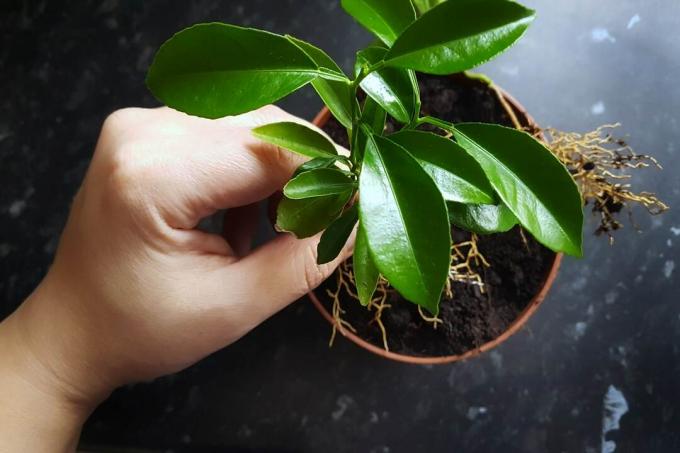
The lemon tree is a popular container plant. However, it is a bit more demanding than many other plants in terms of care. He's happy to lemon Tree while the leaves are hanging. What measures can he be taken to revive?
In a nutshell
- Mistakes in care are the most common cause of drooping leaves
- especially lack of water, waterlogging, soil conditions and cold
- Lemon tree relies on sufficient light and heat
- revitalize through need-based care
Table of Contents
- compensate for lack of water
- Eliminate waterlogging
- Replace substrate
- Keep root area warm
- frequently asked Questions
compensate for lack of water
Due to its Mediterranean origin and the consequent lack of winter hardiness the lemon tree is mainly cultivated in tubs. Since the substrate can quickly times dry out and he lets the leaves hang. Especially since this tree prefers sunny and warm locations. Later, the leaves curl up and fall off. To regenerate, you should immediately water the plant extensively, preferably using the immersion method. This is also how you should proceed when watering:
- Avoid frequent changes of too much or too little water and longer watering breaks
- allow the upper substrate layer to dry in between
- Water daily in summer in a sunny spot
- until water comes out of drain hole
- Keep substrate permanently slightly moist
- especially during the growing season
- Water requirement otherwise not very large

A bucket that is too small can also encourage the substrate to dry out too quickly due to the insufficient volume of soil. Accordingly, you should make sure that the planter is big enough, regularly, i.e. every two to three years at the latest repotted and the pot size of the respective plant is adjusted accordingly.
Tip: To test whether the sapling has dried up, cut a branch or twig until fresh green shows up inside. Then the plant can usually be revived.
Eliminate waterlogging
Not only lack of water, but also too much water can lead to the same problem, the lemon tree lets the leaves droop, they fall off. In this case, saving the plant is usually only promising if the root is not too badly damaged. Fast action is now extremely important. Immediately pot the tree and examine the roots.

- completely remove old soil
- Cut off rotten and dead root parts
- Clean pot thoroughly or replace
- drainage material at the bottom of the pot
- some fresh earth on top
- Plant in the middle
- fill with soil and press down well
- do not water in the first few days
Tip: In order not to promote waterlogging, standing water in coasters should always be removed promptly.
Replace substrate
A poor substrate also has a negative effect on the lemon tree and it lets its leaves droop. A good earth is the basis for healthy growth. For example, if it detaches from the edge of the pot, this usually indicates inferior quality. In this case, you should definitely change the substrate and ensure a permeable, structurally stable soil with good storage capacity.

- should contain compost, coconut fiber, clay minerals, quartz sand and lime
- slightly acidic pH between 5.5 and 6.5
- alternatively use special citrus soil
- or make your own mix
- 1/3 each of compost and garden soil and 1/6 each of sand and clay mineral
- very peaty substrates tend to become waterlogged
- generally avoid peat
Keep root area warm
The location plays an important role in the lemon tree. He doesn't like the cold at all, it slows down the roots so that they can absorb little or no water. In the worst case, the lemon tree will drop its leaves and die. This can be perceived above ground as a lack of water, which it is not. This problem occurs mainly during the wintering on.
It's less about cold rooms and more about cold in the root area. A warm room does not mean a warm substrate. To prevent the plant from dying, you should remove the pot or Keep the root area warm, for example with the help of a special commercially available heat mat.
frequently asked Questions
If the external conditions are right, the cause can lie in the root area. The plant should be potted and the ball or take a close look at the roots and the nature of the substrate. Is the root ball too wet or too dry, are there many fine roots or are they rather rotten and does the substrate meet the specific needs of this plant?
If rainwater or irrigation water can no longer run off, it builds up and waterlogging occurs. If the problem is not recognized, the plant usually dies. In a permanently wet substrate, the roots can no longer absorb oxygen. This in turn means that fungi can thrive optimally and root rot occurs. The roots are then no longer able to absorb water or nutrients, and the lemon tree dies.
In principle, both rainwater and tap water can be used for watering. However, rainwater is optimal, especially when the tap water is particularly calcareous, because the lime content varies depending on the region. If no rainwater is available, the tap water should be well stale before watering.
The lemon tree reacts sensitively to immediate and significant changes in ambient temperature and the amount of light available, usually by letting its leaves droop. This happens, for example, when the plant moves to winter quarters and the conditions change abruptly. He then often loses a large part of his leaves. That's why you should always leave it outside for as long as possible and put it outside again as early as possible in order to avoid major changes or changes. to avoid temperature fluctuations.



